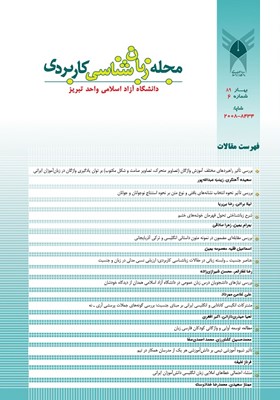A Subjective Needs Assessment of EGP Students at Islamic Azad University of Hamedan
محورهای موضوعی : English Language Teaching (ELT)
1 - Department of English, Hamedan Branch, Islamic Azad
University, Hamedan, Iran
کلید واژه: Syllabus Design, General English, Subjective Needs Analysis,
چکیده مقاله :
The present article reflects the results of a needs analysis survey carried out on a group of 52 students in a general English course at Islamic Azad University of Hamedan, Iran, in which a 32-item questionnaire adapted from Kavaliauskiene and Užpaliene (2003), Iwai et. al (1999) and Seedhouse (1994) is used to investigate the students' conceptions of good learning of English expressed in terms of their own wants and lacks. The results of the data analysis point to a need to improve the course syllabus in different ways.
مقاله ی حاضر گزارشی است از نتایج تحلیل نیازها که بر روی گروهی 52 نفره از دانشجویان زبان انگلیسی در دانشگاه آزاد اسلامی واحد همدان به عمل آمده است و در آن پرسشنامهای با 32 سؤال برگرفته از کاوالیوسکین[1] و یوزپالین[2](2003)، آیوای و همکاران[3](1999) و سید هاوس[4](1994) به منظور بررسی برداشت شخصی دانشجویان از خصوصیات یک دوره ی آموزش زبان انگلیسی موفق مورد استفاده قرار گرفته است. نتایج تجزیه تحلیل داده ها به لزوم تغییر سرفصل درس از جهات مختلف اشاره دارد. [1]. Kavaliauskiene [2].Užpaliene [3].Iwai et. al [4].Seedhouse
Brindley, G. (1984).Needs analysis and objective setting in the Adult Migrant Education Program. Sydney: NSW Adult Migrant Education Service.
Brown, J. D. (1995). The elements of language curriculum: A systematic approach toprogram development. Boston, MA: Heinle & Heinle.
Bosher, S., & Smalkoski, K. (2002). From needs analysis to curriculum development: Designing a course in health-care communication for immigrant students in the USA. English for Specific Purposes, 21, 59-79.
Chaudron, C., Doughty, C., Kim, Y., Kong, D. Lee, J., Lee, Y., Long, M., Rivers, R., & Urano, K. (2005).A task-based needs analysis of a tertiary Korean as a foreign language program. In M. Long. (Ed.), Second language needs analysis (pp. 225-261). Cambridge: Cambridge University.
Cowling, J. D. (2007). Needs analysis: Planning a syllabus for a series of intensive workplace courses at a leading Japanese company. English for Specific Purposes, 26, 426-442.
Dooey, P. (2010). Students’ perspectives of a EAP pathway program. Journal of English for Academic Purposes, 9, 184-197.
Ferris, D. (1998). Students’ views of academic aural/oral skills: A comparative needs analysis. TESOL Quarterly, 32(2), 289-318.
Gillett, A. J.,& Hammond, A. C. (2011). Pre-Master's course design: What can we learn from assessment?. In S. Etherington (Ed.), English for specific academic purposes (pp. 95-101). Reading: Garnet Education.
Hutchinson, T., &. Waters, A. (1987).English for specific purposes. Cambridge: Cambridge University. Press.
Igawa, K. (2007). Issues in English language education at Korean elementary schools. Bulletin of Shitennoji Kyoto University, 219-236.
Iwai, T., Kondo, K., Lim, D. S. J., Ray, G. E., Shimizu, H., & Brown, J. D. (1999).Japanese language needs assessment 1998-1999 (NFLRC NetWork #13) [HTML document]. Honolulu: University of Hawai`i, Second Language Teaching &Curriculum Center. Retrieved fromhttp://www.nflrc.hawaii.edu /NetWorks/
Jasso-Aguilar, R. (2005). Sources, methods and triangulation in needs analysis: a critical perspective in a case study of Waikiki hotel maids. In M. Long (Ed.), Second language needs analysis (pp. 127-158). Cambridge: Cambridge University Press.
Kavaliauskiene, G., & Užpaliene, D. (2003). Ongoing needs analysis as a factor tosuccessful language learning. Journal of Language and Learning, 1 (1).
Kaewpet, C. (2009). Communication needs of Thai civil engineering students. English for Specific Purposes, 28, 266-278.
Kusumoto, Y. (2008). Needs analysis: Developing a teacher training program for elementary school homeroom teachers in Japan. Second Language Studies, 26(2), pp. 1-44.
Masuhara, H., & Tomlinson, B. (2008). Materials for General English. In B. Tomlinson (Ed.), English language learning materials: A critical review (pp. 17-37). New York: Continuum.
Nunan, D. (1988).The learner - centre curriculum. Cambridge University Press.
Read, J. (2008). Identifying academic language needs through diagnostic assessment. Journal of English for Academic Purposes, 7, 180-190.
Richards, J, C., Platt, J., & Platt, H. (1992).Dictionary of language teaching & applied linguistics. London: Longman.
Seedhouse, P. (1994). From needs analysis to course design. The University of York. Department of Educational Studies. Retrieved from: http://www.nflrc.hawaii.edu/NetWorks/
Seedhouse, P. (1995). Needs analysis and the general English classroom. ELT Journal, 48 (1).
West, R. (1994).Needs analysis in language teaching. Language Teaching, 27(1).
Yalden, J. (1987) Principles of course design for language teaching. Cambridge University Press.


